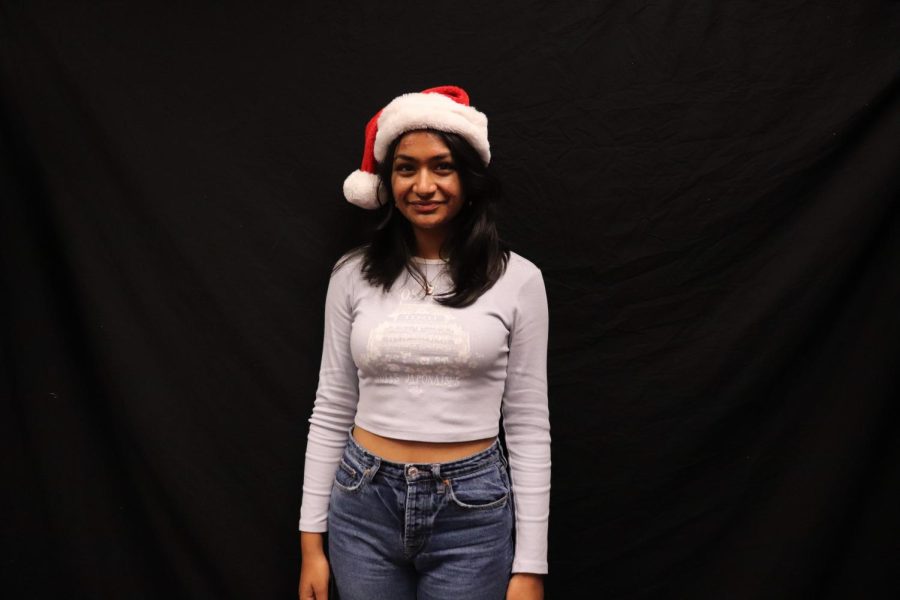A non-Christian merry Christmas
Christmas and Navratri both connect us to religion and culture but much more importantly to a familial bonding and goodwill.
December 7, 2021
Screeching songs about jingle bells, throwing tinsel on trees, hastily wrapping last-minute gifts and baking box double-chocolate brownies for a fat white man and his fat reindeer — while my phony Christmas-infused childhood seems to desperately cling to American traditions, Christmas has always been a way for my immigrant family to pave concrete customs in a new environment. The holiday was more than just a chance for cultural assimilation. It was also an opportunity for holiday fervor, a thing that every 5-year-old craves. Two weeks off of school and a federal holiday for my working immigrant parents were just another reason to get into the jolly spirit, with the context of religion overlooked.
My earliest memories of Christmas, rough around the edges and a bit pathetic, involve sculpting little gingerbread men ornaments out of clay — they were fun at school but wildly out of place at home. After all, as a Hindu family, we had no real need for a Christmas tree. Our holidays were different — Navratri and Diwali instead of Thanksgiving and Christmas — during which we would gather herds of relatives to eat, talk and bond. But with glass ornaments and sugar cookies in hand, my elementary-school self introduced a Christmas tree into our home, beginning my Christmas craze.
The days leading up to Christmas each year still consist of my brother and I throwing around phrases like “Letters to Santa” while simultaneously striking bargains with our parents on budgets for gifts and whether to have a Christmas dinner or not. There’s one annual conversation that I vividly associate with the holiday season: Me pestering my mom about what she wanted for Christmas, and she responding with what I found to be the most infuriating answer: world peace. The answer was my most exasperating enemy, ironic given how committed I was to the do-gooder Christmas spirit. I was looking for something I could make or ask my dad to order on Amazon.
But the traditions that had begun as an inundated ritual transformed into a genuine source of joy and connection. I would wake up to the morning sunshine, wiggling my toes in fuzzy green-and-red socks and poking my resting parents until they woke up — the day’s plans consisted of climactic gift-unwrapping, calling overseas family members and cooking traditional South Indian food, our personal touch. Our family savors the Christmas routine having evolved from the ambition of an overzealous 5 year old. Despite my mother’s annual request for world peace, our immigrant family has been able to ease into the American-style Christmas that overzealous 5-year-old always dreamed of.
My childhood was marked by two wondrous annual occasions. Around October, there’s the Hindu festival, Navaratri, and of course, in December, Christmas. Despite the seeming irony, the celebrations are not just about religion for me or my family. Saved for two holidays, a dusty corner of our living room sits empty for most of the year. Only in retrospect did the irony of two different religions become clear. However the celebrations are not just about religion.
During Navratri, we set up a display of dolls in that corner, use a Costco-sized bag of sugar to make sweets and stay up late gazing at the lights and colors swimming in front of us. It takes weeks of bargaining and whining after the holidays for us to have the heart to finally deconstruct the display.
The corner sits empty for an uneventful month until December, when my family and the rest of America unbox glass ornaments and put on our Santa hats. The warmth and radiance returns to the corner as our Christmas tree goes up, and despite the different religious connotations of both holidays, there’s a striking resemblance in the way we celebrate and who we have become. We buy another bag of sugar, spend late nights admiring the string lights on our tree and hold off till New Years to take down the tree. Christmas and Navratri both connect us to religion and culture but much more importantly to a familial bonding and goodwill.




























































